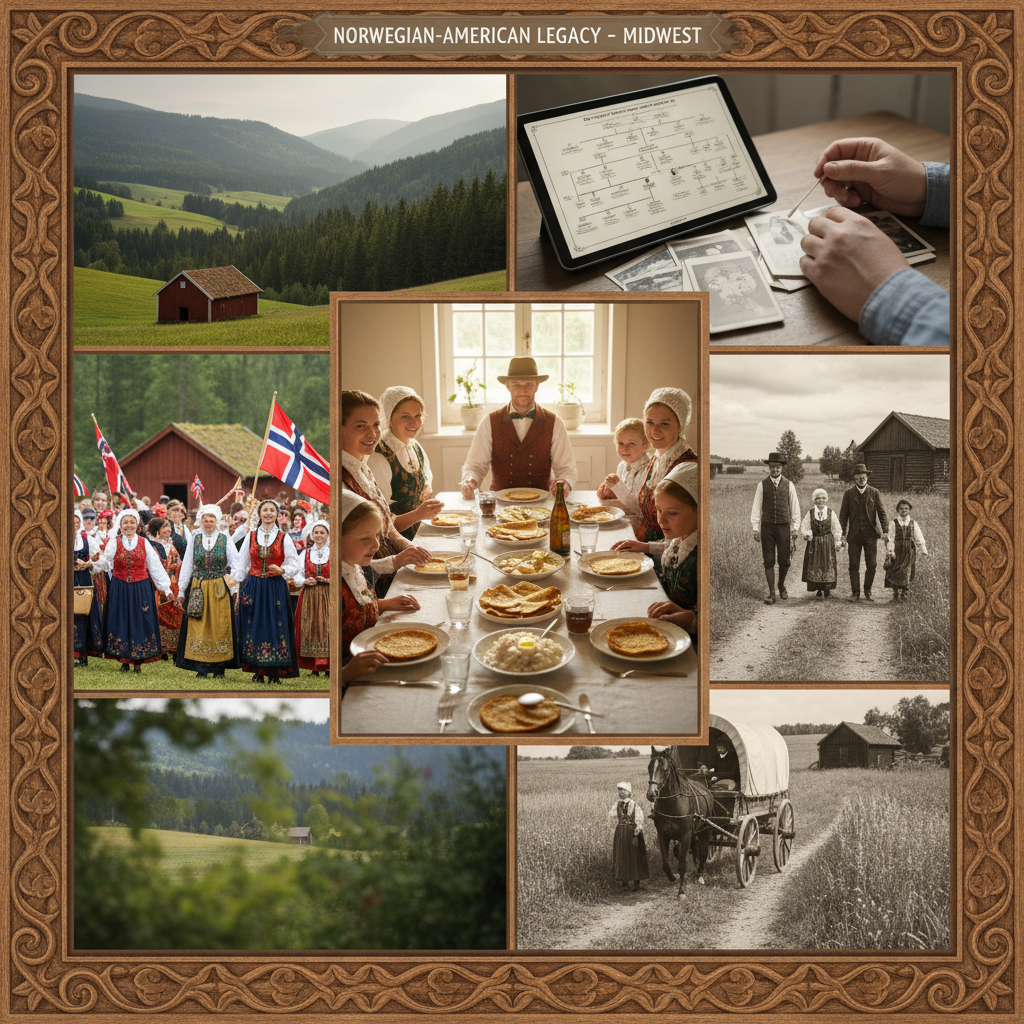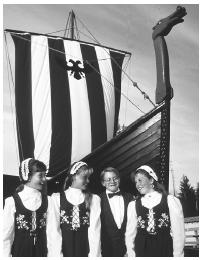
The Enduring Legacy of Norwegian Immigrants in the United States
Norwegian immigrants have profoundly influenced American culture, particularly in the Midwest, where they established thriving communities from the 19th to early 20th centuries. Driven by economic hardships and political unrest in Norway, many sought opportunities in the U.S., settling in states like Minnesota and Wisconsin. Despite facing discrimination and language barriers, they preserved their heritage through cultural societies, festivals, and traditions such as Syttende Mai celebrations and traditional Norwegian foods. The deep connection to nature also shaped their communities, reflecting a love for outdoor activities. Over time, research on Norwegian immigration has broadened, highlighting integration patterns and the impact of U.S. immigration laws. Today, millions of Americans with Norwegian ancestry explore their roots through genealogy and cultural engagement, sustaining a vibrant legacy of resilience and cultural preservation.
Summary
The Enduring Legacy of Norwegian Immigrants in the United States
Norwegian heritage has left an indelible mark on American culture, especially in the Midwest, where waves of Norwegian immigrants established vibrant communities in the 19th and early 20th centuries. This article delves into the rich tapestry of Norwegian-American life, exploring how these immigrants maintained their cultural identity while adapting to their new homeland. We'll look at the historical challenges they faced, the evolution of research on their immigration experience, and the lasting impact of Norwegian traditions in the U.S.
Key Takeaways: - Over 4.5 million Americans claim Norwegian ancestry, with significant populations in the Upper Midwest. - Norwegian immigrants preserved their heritage through cultural societies, festivals, and traditional practices. - Historical migration waves were influenced by economic conditions in Norway and opportunities in the U.S. - Changes in U.S. immigration laws significantly affected the Norwegian community's growth and integration. - Research on Norwegian immigration has broadened from cultural preservation to broader immigration studies.
The Journey and Settlement of Norwegian Immigrants
Historical Migration Waves
Norwegian immigration to the United States peaked from the 1820s to the 1920s, driven by various factors. Economic downturns in Norway, coupled with land scarcity and political unrest, pushed many to seek better opportunities abroad. The promise of the American frontier, particularly the Midwest, offered fertile land through initiatives like the Homestead Act, which facilitated ownership for immigrants. This era saw significant Norwegian settlements in states like Minnesota, Wisconsin, and North Dakota, where the landscape reminded them of their homeland.
Challenges of Integration
Upon arrival, Norwegian immigrants faced several challenges. Discrimination was prevalent, with nativist sentiments often viewing them as outsiders. However, their strong work ethic and community spirit helped them integrate. Language barriers were another hurdle, but Norwegian communities established schools and churches where both Norwegian and English were taught, easing the transition for newer generations. The Law of Jante, emphasizing humility and collective well-being, played a role in how these communities interacted within the broader American society, often leading to a harmonious but distinct cultural identity.
Preservation of Norwegian Heritage in America
Cultural Societies and Events
Organizations like the Sons of Norway have been pivotal in preserving Norwegian traditions. These societies organize events like Syttende Mai, Norway's Constitution Day, which has become a major celebration in places like Minneapolis. They also offer language classes, cultural workshops, and scholarships, ensuring that Norwegian heritage is passed down through generations. Traditional foods like lutefisk and lefse remain popular at these gatherings, reinforcing cultural ties.
The Role of Nature in Norwegian-American Identity
The concept of natur (nature) is deeply ingrained in Norwegian culture, influencing how Norwegian-American communities developed. Urban planning in these areas often includes ample green spaces, reflecting a Norwegian love for the outdoors. Activities like skiing, fishing, and hiking are not just recreational but cultural, connecting Norwegian-Americans to their ancestral roots.
Evolution of Immigration Research
From Ethnic Studies to Broader Immigration Phenomena
Initially, research focused on the preservation of Norwegian traditions and the unique aspects of Norwegian society within America. Over time, this has evolved into a broader study of immigration phenomena. Scholars now compare Norwegian immigration with other groups, analyzing integration strategies, the impact of immigration laws like the Immigration Act of 1924, and how these policies shaped community dynamics. This shift reflects a growing understanding of immigration as a multifaceted process affecting identity, policy, and cultural evolution.
Modern Perspectives on Norwegian Ancestry
Today, many Americans with Norwegian ancestry delve into genealogical research and DNA testing to reconnect with their roots. This interest is supported by cultural societies and digital platforms, making it easier to trace lineage and engage with Norwegian identity. This modern exploration often blends with American culture, creating a hybrid identity that respects both heritages.
Conclusion
The story of Norwegian immigrants in the United States is one of resilience, cultural preservation, and adaptation. From facing historical challenges to maintaining vibrant traditions, Norwegian-Americans have contributed significantly to the cultural mosaic of the U.S. As research continues to evolve, it not only honors their past but also informs our understanding of immigration dynamics today, ensuring that the legacy of Norwegian heritage remains vibrant and relevant.

Frequently Asked Questions
Q: Norwegian immigration to the US history
A: Norwegian immigration to the United States began in significant numbers during the early 19th century, primarily motivated by economic hardships, lack of available land, and the promise of opportunities in America. Large waves of Norwegians settled mainly in the Midwest, especially in states like Minnesota, Wisconsin, and Iowa, where they established farming communities. The Homestead Act of 1862 encouraged many Norwegians to immigrate by offering free land to settlers willing to cultivate it. Over time, Norwegian Americans contributed to the cultural and economic fabric of the US, maintaining their heritage while integrating into American society.
Q: Norwegian heritage in America
A: Norwegian heritage in America is rich and influential, stemming from large waves of immigration in the 19th and early 20th centuries. Norwegian immigrants settled predominantly in the Midwest, especially in states like Minnesota, Wisconsin, and North Dakota, where they contributed to farming, cultural traditions, and community building. Today, Norwegian-American communities celebrate their heritage through festivals, museums, and organizations that preserve Norwegian language, customs, and history. This heritage is also reflected in American cuisine, folk art, and Lutheran church traditions.
Q: challenges faced by Norwegian immigrants
A: Norwegian immigrants often face challenges such as adapting to new cultural norms and language barriers, which can affect their social integration and employment opportunities. They may experience homesickness and difficulties maintaining their cultural identity while adjusting to differing social customs and climates. Additionally, navigating legal and bureaucratic systems in their new country can pose challenges, especially for those unfamiliar with the immigration policies and support services available.
Q: Norwegian traditions in the US
A: Norwegian traditions in the US are prominently celebrated in communities with strong Norwegian heritage, especially in the Midwest states like Minnesota and North Dakota. These traditions include celebrating Syttende Mai (Norwegian Constitution Day) with parades, traditional folk music, and Norwegian foods such as lefse and lutefisk. Cultural events often feature bunads, the traditional Norwegian costumes, and folk dancing to preserve and honor Norwegian heritage in American society.
Q: impact of immigration laws on Norwegian immigrants
A: Immigration laws significantly influence the experiences of Norwegian immigrants by determining their eligibility for entry, residency, and work permits in a host country. Stricter laws can limit opportunities for Norwegians seeking to move abroad, affecting family reunification or employment options. Conversely, more lenient policies may facilitate easier integration and access to social services. Additionally, changes in immigration laws can impact the legal status and stability of Norwegian immigrants, influencing their long-term settlement and contribution to society.
Key Entities
Julia Ronning: Julia Ronning is an expert in immigration policy and social justice advocacy. She frequently contributes to discussions on the impact of immigration enforcement on communities.
Becky Kroll: Becky Kroll is a journalist known for her work covering social and cultural issues. Her reporting often highlights marginalized voices and systemic inequalities.
Michele Waslin: Michele Waslin is a researcher specializing in immigration and labor policy. She provides analysis on U.S. immigration enforcement and its consequences for workers.
Caitlin Sackrison: Caitlin Sackrison is a writer and editor focused on social justice and immigrant rights. She contributes research and commentary on immigration reform and policy.
Olivia Gunn: Olivia Gunn is a public policy expert who focuses on immigration and civil rights. She engages in advocacy aimed at protecting immigrant communities.
External articles
- Discover Your Norwegian Immigration Roots
- Norwegian Americans
- Scandinavian | Immigration and Relocation in U.S. History
Related Articles
- Assessing Donald Trump's Prospects for the Nobel Peace Prize: Independence, Criteria, and Controversies
- Rising Interest in Norwegian Language and Culture Among Young Americans
YouTube Video
Title: Struggling with small talk in Norway? 🌧
URL: https://www.youtube.com/shorts/CcVUfMGTVvg
Life